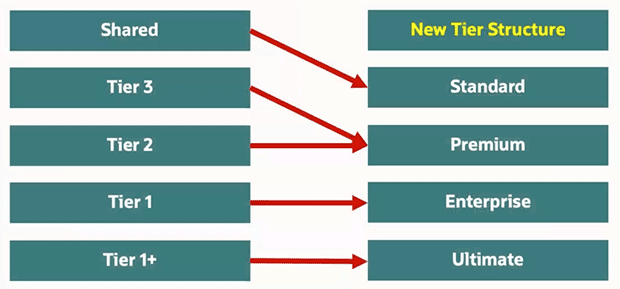NetSuite announces new service tier levels

NetSuite offers different levels of service tiers to allocate appropriate system resources and performance capabilities based on user count, file storage, monthly transactions, and integration needs. The different service tiers provide companies an ERP platform that scales with them as they grow. NetSuite recently modified the service tier structure to more closely align with the business needs of its customers.
New tier naming conventions
The five tiers (Shared, Tier 3, Tier 2, Tier 1, and Tier 1+) that NetSuite previously offered have now been consolidated to four tiers with a new naming convention (Standard, Premium, Enterprise, and Ultimate). The mapping of the old tiers to the new tiers is illustrated below. The primary difference is that Tier 3 and Tier 2 have now been combined into the single Premium tier.

Simplified calculations
The previous service tiers were based on the number of users, file storage, and business data storage. Because business data storage is difficult to conceptualize, the business data storage component of the service tiers has been replaced with monthly transaction line count. Though each tier has a limit of monthly transaction lines, NetSuite uses a rolling six-month average to determine this. A spike in transactions for one month does not necessitate moving to a higher tier. However, if you are continually exceeding the counts it will be necessary to upgrade to a higher service tier in order to get the best level of performance out of the system. NetSuite offers full visibility and traceability into this metric using a self-service activity in your account. This can be accessed from within NetSuite while logged in with an administrator role under Setup >> Company >> View Billing Information.
Increased capacity
NetSuite also increased the capacity limits of each service tier. On average, the file cabinet storage limit has increased by a factor of 10. For example, the new standard tier has 100 GB of file cabinet storage and the shared tier it replaces only had 10 GB. Additionally, the number of users in the service tiers has been increased as well. For example, Tier 3 used to have a maximum of 150 users and tier 2 had a maximum of 800 users. Both of these tiers have been rolled into the “premium” tier which has a limit of 1000 users. Another added benefit is all service tiers above standard now include a sandbox.
The below chart displays the new service tier levels and their capacity:
Integrations also impact the level of service tiers. For organizations with a lot of integrations, it may be necessary to purchase additional SuiteCloud Plus licenses which will increase the throughput and parallel threads that can exist. Each tier has a limit on the maximum number of SuiteCloud licenses. Those limits have been increased in the new service tiers. For example, in the old tier 1 there was a maximum of 5 SuiteCloud licenses and in the enterprise tier that replaces it, there is a maximum of 6. The previous service tiers had a minimum number of SuiteCloud licenses which has now been dropped. This requirement has been dropped because an organization could need a higher service tier due to number of users or transactions but not have a lot of integrations and therefore not need a lot of SuiteCloud licenses. The below chart shows the new service tiers and the integration thresholds for each:
Next steps
If you have questions about the new service tier changes or how to get the best performance out of NetSuite, Rand Group can help you. We are an experienced NetSuite Solution Provider that can examine your organization‘s needs and make knowledgeable recommendations. Contact a NetSuite expert today.
For information on how much each NetSuite service tier costs, download this pricing guide.
NetSuite pricing guide
NetSuite offers a unique modular approach to subscription licensing for customers by providing licensing designed to provide the right value for your business. This includes modules that have competitive monthly prices for emerging (small) businesses, midmarket, and enterprise, and by industry such as wholesale distribution, manufacturing and retail, plus add-ons for expansion such as warehouse management.



